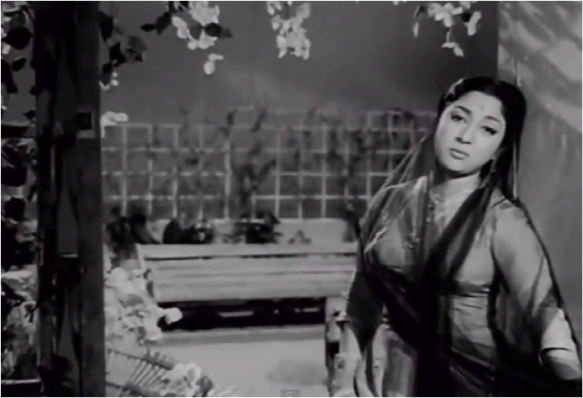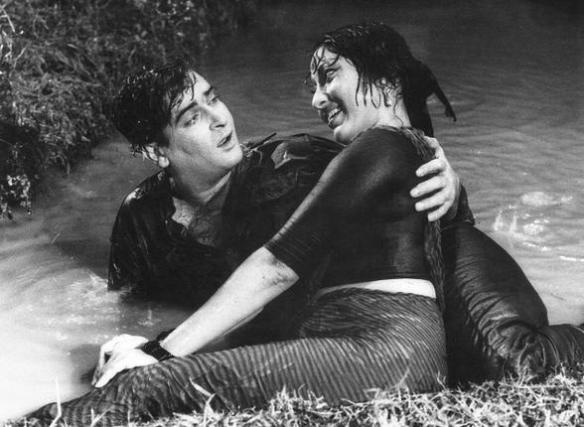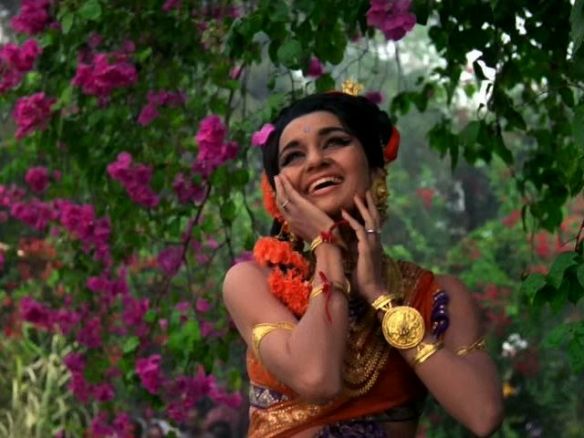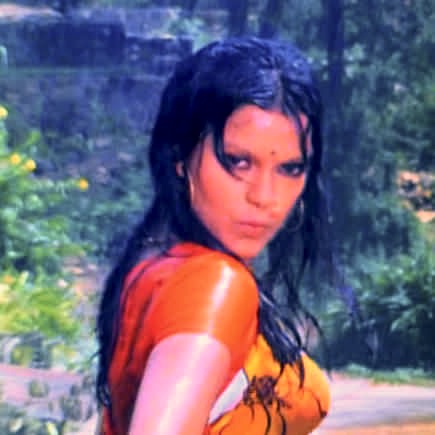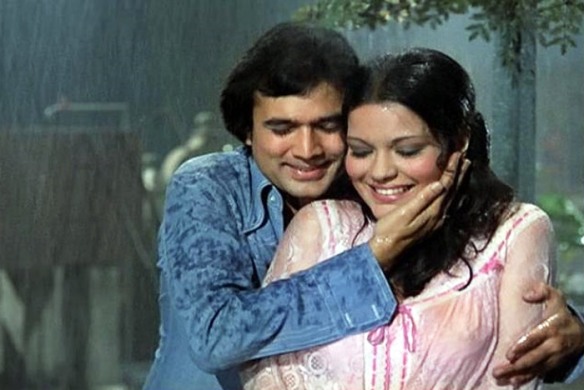
Tanuja and Mala Sinha play sisters with opposite personalities who love with the same man in Baharen Phir Bhi Aayengi (1966).
Today we highlight the lyrics and English translation of the gorgeous “Aap Ke Haseen Rukh Pe” from Baharen Phir Bhi Aayengi (1966). The breathtakingly evocative cinematography of this song steals the show–and that’s a difficult feat with Urdu lyrics dripping with this much beauty. Eminent director Guru Dutt tragically died while directing this film, and it was later finished by Shaheed Latif. As a result, Baharen Phir Bhi Aayengi seems to have all the elements of a great work of poetic realism, but lacks all the magic. Dutt’s starring role was eventually replaced by Dharmendra, who is easy on the eyes, but never quite commands the scene like his predecessor.
Dharmendra plays an upright investigative journalist employed by a newspaper company owned by Mala Sinha, a pragmatic entrepreneur fighting for her beliefs in a male-dominated world. Her personal sacrifices have allowed for her younger sister (played by Tanuja) to be raised in a lifestyle of ease and self-indulgence. Mala Sinha begins to fall in love with Dharmendra as his caring manner and flattering attentions opens up the possibility for the romantic fulfillment she had long denied herself. Meanwhile, Tanuja’s girlishly flirtacious advances toward Dharmendra appear not unwanted, completing the dramatic love triangle. Neither sister knows of the other’s intentions, and the audience anxiously awaits the moment when one will discover the truth. Whom will Dharmendra ultimately choose?
At least for the audience, that answer comes during one of the most romantic Mohammed Rafi songs of Bollywood: “Aap Ke Haseen Rukh Pe.” The cinematography of the film is by K.G. Prabhakar (whose strong legacy includes working as assistant camera in Guru Dutt masterpieces Sahib Bibi Aur Ghulam, Kaagaz Ke Phool and Pyaasa). The first thing you might notice about Baharen Phir Bhi Aayengi is the (lack of) colour. By 1966, Eastmancolor was by far the norm in Bollywood. Shooting this film in black-and-white stock therefore was a deliberate choice. Guru Dutt never filmed a movie in color (with the exception of a rare scene here and there, eg. “Chaudhvin Ka Chand“), and his films carry a haunting charm. Prabhakar uses creative camera angles and perfectly choreographed movements to convey the message of true love. The exquisite cinematography coupled with a combination of Anjaan’s ornate balladry, the dreamlike piano solo, and Mohammed Rafi’s hypnotically romantic vocals make this song a vision of what film should be.

Shots of the two sisters mimic one another throughout “Aap Ke Haseen Rukh Pe,” heightening the dramatic irony. Here, both sisters shyly glance up toward Dharmendra as they each believe lines from his song are sung exclusively for them. Even their cat-eyeliner and penciled eyebrows are in fierce competition.
Early in the song, the camera choices are critical to casting doubt about to whom Dharmendra is truly singing. Prabhakar shoots the siblings’ reactions and movements in parallel, with each sister’s gazes mimicking the other such that even the audience grows uncomfortable, knowing one of them must be mistaken.

This master shot creates a literal love triangle in the mis-en-scene and defines both their spatial and emotional relationships.
By the middle of the song, both sisters approach Dharmendra so that all three can be captured in the same shot, creating a fascinating opportunity for the cinematographer. In the master shot pictured above, the camera is placed behind Dharmendra’s shoulder, creating a visual triangle formed by the lid of the grand piano to underscore the romantic triangle blossoming before our eyes. This angle also allows a gorgeous moment of symbolism within the mis-en-scene through the placement of the main characters. Tanuja, whose love is confident and eager, leans toward Dharmendra into the light source, while Mala Sinha, whose love is more careful and protected, stands further away in the shadows, avoiding his direct gaze. Sinha is framed by the piano lid at the pinnacle of the triangle, literally surrounded by the music that has changed how she views the world.

From a profile shot of Dharmendra to a medium reaction shot of Mala Sinha, the eyelines are ambiguous. Is he singing to Tanuja or to Mala Sinha?
Next, the audience is cleverly teased by the camera with a series of shots that heighten the romantic ambiguity. Prabhakar films a profile shot of Dharmendra singing, so that from the viewer’s perspective, he is just as likely to be making eye contact with Mala Sinha as with Tanuja. He brings the camera into Dharmendra’s seat for Mala Sinha’s reaction so that what we see is as if from Dharmendra’s own perspective. Tension mounts! A reverse shot from Mala Sinha’s position of Dharmendra would close the communicative loop, and we would finally have our answer that the two are definitely looking at one another, and both know it. Alas! Baharen Phir Bhi Aayengi is not so simple.

The classic over-the-shoulder shot-reverse shot sequence ultimately seals Tanuja as the object of Dharmendra’s affection.
Finally, the camera gives its long-held secret away. At the end of the ballad, two consecutive shots with matching eyelines betray Tanuja and Dharmendra as the primary romantic couple of the film. The camera cuts from an over-the-shoulder shot of Tanuja to a reverse over-the-shoulder shot of Dharmendra. His gaze is now clearly directed at only one sister. Meanwhile, Mala Sinha appears tragically oblivious, wandering to the window to daydream of what we now know is impossible.
We hope you fall in love with the lyrics and our English translation of “Aap Ke Haseen Rukh Pe” below. When words like chuur-chuur and kashish are tossed around lightly in a Bollywood song, you know you’re in for some solidly gorgeous poetry! Follow along with the cinematography of the film here and let us know which sister you were rooting for in the comments!
Aap Ke Haseen Rukh Pe Lyrics and Translation:
aap ke hasee.N rukh pe aaj nayaa nuur hai
Upon your beautiful face today is a new light
meraa dil machal gayaa, to meraa kyaa qusuur hai?
If my heart trembled, what fault is it of mine?
aap kii nigaah ne kahaa to kuch zaruur hai
Your glance said something surely
meraa dil machal gayaa to meraa kyaa qusuur hai?
If my heart trembled, what fault is it of mine?
khulii laTo.N ki chhaao.N mei.N, khilaa khilaa yeh ruup hai
In the shade of your open tresses, this beauty bloomed
ghaTaa se jaise chhan rahii, subaah subaah kii dhuup hai
As if morning sunlight is streaming through a cloud
jidhar nazar muDii ,udhar suruur hii suruur hai
In whichever direction my gaze turns, there is only pleasure upon pleasure
meraa dil machal gayaa to meraa kyaa qusuur hai?
If my heart trembled, what fault is it of mine?
jhukii jhukii nigaah mei.N bhii hai.N balaa ki shokhiyaa.N
In your shy lowered gaze is also a calamity of mischief
Dabii Dabii ha.Nsii mei.N bhii, taDap rahii hai.N bijliiyaa.N
Even in your suppressed laughter, lightening is pulsing
shabaab aap kaa nashe mei.N khud hii chuur-chuur hai
Your youthfulness dissolves itself in intoxication
meraa dil machal gayaa to meraa kyaa qusuur hai?
If my heart trembled, what fault is it of mine?
jahaa.N jahaa.N paDe qaDam, wahaa.N fizaa badal gayii
Wherever your foot falls, there the wind changes
ki jaise sar-basar bahaar aap hii mei.N Dhal gayii
As if the whole of Spring descended into you
kisi mei.N yeh kashish kahaa.N jo aap mei.N huzuur hai?
Where is this allure in anyone that is present in you?
meraa dil machal gayaa to meraa kyaa qusuur hai?
If my heart trembled, what fault is it of mine?
aapke haseen rukh pe aaj naya noor hai
Upon your beautiful face today is a new light
meraa dil machal gayaa to meraa kyaa qusuur hai?
If my heart trembled, what fault is it of mine?
aap kii nigaahon ne kahaa to kuch zaruur hai
Your glances said something surely
meraa dil machal gayaa to meraa kyaa qusuur hai?
If my heart trembled, what fault is it of mine?
Hmm hmm hmm…hmm hmm hmm
Glossary:
hasee.N: beautiful; rukh: face; aaj: today; nayaa: new; nuur: light; dil: heart; machalnaa: to quiver, to tremble; qusuur: fault; nigaah: glance; zaruur: surely, of course; khulaa: open; laT: tresses; chhaao.N: shadow, shade; khilnaa: to bloom; ruup: beauty; ghaTaa: cloud; chhannaa: to stream; subaah: morning; dhuup: sunlight; jidhar; in whichever direction; nazar: gaze, eyes; muDnaa: to turn around; udhar: in that direction; suruur: pleasure, addiction; jhuknaa: to bow, to lower; balaa: calamity, misfortune; shokhii: mischief; Dabnaa: to suppress; ha.Nsii: laughter; taDapnaa: to flutter; bijlii: lightening; shabaab: youth; nashaa: intoxication; khud: self; chuur-chuur: pulverized, dissolved; jahaa.N: where; paDnaa: to step; qadam: footstep; wahaa.N: there; fizaa: wind, atmosphere; badalnaa: to change; jaise: like, as if; sar-basaar: entire, whole; bahaar: Spring; Dhalnaa: to set, to descend; kisii mei.N: in someone; kashish: allure, charm; huzuur: present
A brief word on the nuances between English and Urdu-Hindi. I struggled to translate bijliiyaan and shokhiyaan, plurals of the feminine nouns bijlii and shokii respectively. In English, the word lightening does not necessarily imply the number of bolts (singular versus plural), however bijliyaan clear indicates multiple bolts of lightening. Similarly, shokhii, meaning mischief in English, becomes a series of mischievous activities in the plural shokhiiyaan–however there is no simple plural of the word mischief in English (although in and of itself, the word mischief in English can imply plurality, but not necessarily). I also find that when used in Urdu-Hindi, especially romantic songs, shokhii has a much more playful connotation than the potentially negative associations of mischief in English. Isn’t language a wonderful thing?

A stunning dolly shot of Mala Sinha from outside the window represents her emotional imprisonment from which Dharmendra offers a chance at escape.





